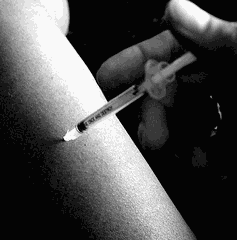DHE Migraine Treatment: Why some people still use it
To get some background on DHE migraine treatment, we need to go back to the days before DHE, or dihydroergotamine, was used. It was actually in 1925 that the first migraine patient got an injection of ergotamine tartrate. It worked – stopping the migraine that just wasn’t going away.
In 1943 came the next step for "ergot treatment" – DHE, the long name being dihydroergotamine. It was first used at the Mayo Clinic.
Yes, 1943.
Since then, our understanding of migraine has been completely transformed. And yet, some people are still using DHE to stop migraine attacks. Why?
Earlier this week I asked on Twitter who had used DHE lately, and got a helpful response from @maxjerz, who had used IV treatment to stop a migraine that, again, was not going away – 24/7 pain.
 Photo courtesy of BlueGoa |
That answer is actually typical – DHE is often given for migraine attacks that aren’t being stopped using more common medication. DHE IV therapy isn’t the only way to go – it can also be injected intramuscularly or subcutaneously. I’ve used it myself, and let me tell you sticking a needle in your body when you’re more sensitive to pain than ever isn’t fun (and for me wasn’t any help) (read Robert’s experience with DHE).
Just last month a report came out of the Cincinnati Children’s Hospital Medical Center in Ohio, USA about using DHE migraine treatment on children and adolescents with status migraine (again, migraine that ain’t going away – an attack lasting more than 3 days). The results were encouraging – almost 3/4 of the patients became pain-free (excellent considering their normal medication wasn’t working). Read the study on DHE migraine treatment for children and adolescents.
So DHE (sold as DHE-45 and Migranal) is still given to patients who aren’t being helped by other medications, and because it’s an injection it can be used for patients who have nausea. It also may help with allodynia (sensitive/painful skin – a common symptom of migraine).
So – why don’t MORE people use it?
So maybe our question should be – why isn’t DHE migraine treatment used more often? Here’s why dihydroergotamine is no longer at the top of most doctor’s lists:
- Side effects: Serious side effects are rare, but they’re serious enough to make one cautious. Possible problems include cardiac events, increase in blood pressure, and spasms of blood vessels.
- Drug interactions: There are a large number of drug interactions that you need to worry about with DHE, such as certain antibiotics, triptan drugs, and protease inhibitors. It’s recommended you carefully go through any drugs you’re taking or may take and let your doctor know before using DHE migraine treatment.
- Other cautions: Like many drugs for migraine, DHE can’t be used by pregnant or nursing mothers. There’s also concern about patients with hypertension, certain types of migraine, and patients with peripheral arterial disease (to name a few).
- Rebound headache: Taking DHE may lead to rebound headache, where the migraine attacks start coming stronger and faster because of the medication itself.
Obviously other drugs have many side effects, and other cautions, but the concerns with DHE may be higher compared to the benefit, depending on the patient. For most people, other treatments will work better. But a doctor who knows your medical history may suggest DHE for your case individually.
So, although your doctor will have good reasons for recommending other medications first, DHE may still be the perfect thing to end the migraine symptoms in certain patients.
Read more technical details about dihydroergotamine msylate here.
